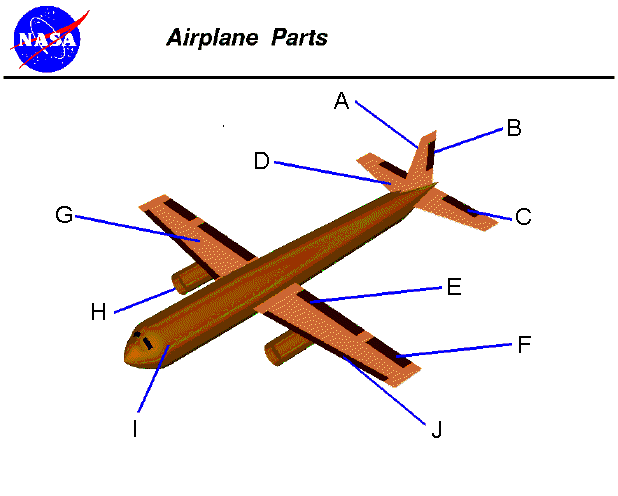|
|
-
Airplane
Parts/Functions Problems
If so instructed by your teacher, print out a worksheet page for
these problems.
Open the slide
called Airplane Parts Definitions
(with text) and read the explanation of the parts of an airplane and
their functions. For more information on airplane parts and their functions
refer to the following slides:
Fuselage,
Wing Geometry,
Jet Engines,
Flaps and Slats,
Spoilers,
Elevator,
Aileron, and
Rudder (with text).

Using the picture above
and a little imagination, answer the following questions. The motion of
all airplane parts is as if you were looking at the airplane from the front.
- What are the names
of the parts of the airplane pictured above?
- A:_____________________________________________
- B:_____________________________________________
- C:_____________________________________________
- D:_____________________________________________
- E:_____________________________________________
- F:_____________________________________________
- G:_____________________________________________
- H:_____________________________________________
- I:_____________________________________________
- J:_____________________________________________
- Describe the following
aircraft motions.
- Pitch:
____________________________________________
- Roll: ____________________________________________
- Yaw: ____________________________________________
- Loop: ____________________________________________
- Dive: ____________________________________________
- Climb: ____________________________________________
- Lift: ____________________________________________
- What are the functions
of the parts of the airplane pictured above?
- A:_____________________________________________
- B:_____________________________________________
- C:_____________________________________________
- D:_____________________________________________
- E:_____________________________________________
- F:_____________________________________________
- G:_____________________________________________
- H:_____________________________________________
- I:_____________________________________________
- J:_____________________________________________
- Which parts are
used to control lift at low speed for takeoff and landing?
- Which parts, installed
one to each wing, operate in opposite directions (i.e., one up and one
down)?
- If the part in
Problem 4 on the right wing is up and the one on the left wing is down,
what will the airplane do?
- If the pilot lowers
the elevator, what will the airplane's tail do?
- What will this
in turn cause the airplane's nose to do?
- If the pilot moves
the rudder to the left, what will the airplane's tail do?
- What will this
in turn cause the airplane's nose to do?
- What motion will
occur in an airplane with the elevator deflected up and the rudder deflected
to the right?
- What is a spoiler?
Enrichment Activity:
Have students make
paper airplanes with control surfaces. Then have them predict airplane
movement and test their predictions for different combinations of elevator,
rudder, and aileron positions. For other paper airplane activities, go
to the following sites:
1. Paper
Airplane Activity (http://www.grc.nasa.gov/WWW/K-12/aerosim/LessonHS97/paperairplaneac.html)
2.
How to Build a Paper Jet Model (http://www.grc.nasa.gov/WWW/K-12/WindTunnel/Activities/foldairplane.html)
|
